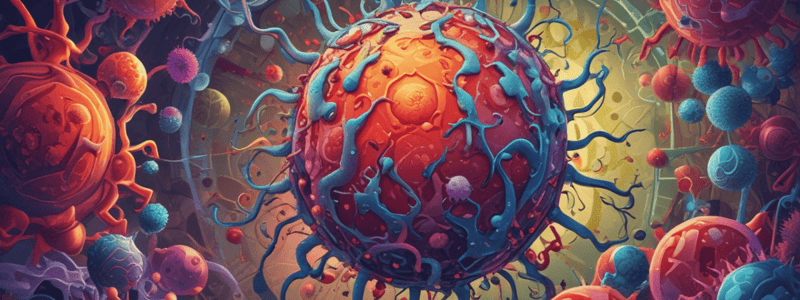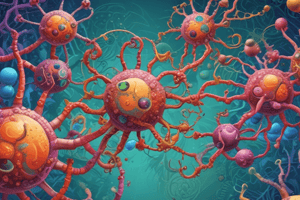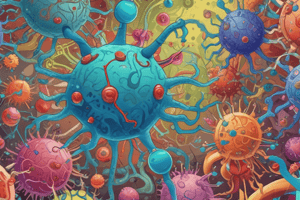Podcast
Questions and Answers
What is a characteristic of viruses?
What is a characteristic of viruses?
- They are true living cells
- They have metabolic activities
- They require host cells for replication (correct)
- They take in nutrients and expel wastes
What is the composition of a virus?
What is the composition of a virus?
- Lipid, protein, and nucleic acid
- Nucleic acid and protein (correct)
- Only nucleic acid
- Only protein
Why are viruses so small?
Why are viruses so small?
- Because they have a large number of genes
- Because they require host cells for replication
- Because they can only carry a few genes (correct)
- Because they are not living cells
What is the purpose of receptors on the surface of host cells?
What is the purpose of receptors on the surface of host cells?
How do antiviral drugs work?
How do antiviral drugs work?
What is the mechanism of viral entry?
What is the mechanism of viral entry?
What happens once the virus is inside the host cell?
What happens once the virus is inside the host cell?
Why do viruses only cause specific infections?
Why do viruses only cause specific infections?
What is the reason why some viruses have additional steps in their replication process?
What is the reason why some viruses have additional steps in their replication process?
What is the first step in the replication process of a virus?
What is the first step in the replication process of a virus?
What is the phase of replication where the virus takes over the host cell's machinery?
What is the phase of replication where the virus takes over the host cell's machinery?
Why can't antiviral drugs target the host cell enzymes used by viruses for replication?
Why can't antiviral drugs target the host cell enzymes used by viruses for replication?
What is the basis of the nucleoside analogs used to treat diseases such as HIV?
What is the basis of the nucleoside analogs used to treat diseases such as HIV?
What is the reason why antiviral drugs cannot kill viruses?
What is the reason why antiviral drugs cannot kill viruses?
What is the last step in the replication process of a virus?
What is the last step in the replication process of a virus?
What is the phase of replication where the virus's proteins and nucleic acids are packaged into new virions?
What is the phase of replication where the virus's proteins and nucleic acids are packaged into new virions?
Study Notes
Characteristics of Viruses
- Not true living cells
- Do not take in nutrients or expel wastes
- Require host cells for replication
- No metabolic activities
- Consist of only nucleic acid (either DNA or RNA) and protein
- May be enclosed in a lipid and protein envelope
- Very small, require an electron microscope to be viewed
- Can only carry a few genes
Viral Infection and Replication
- Viruses rely on host cells for metabolic functions
- Need to enter host cells and take over cellular machinery
- Recognize specific molecules on cell surface to bind and gain entry
- Use receptors to enter cells (e.g. sialic acid for influenza virus)
- Antiviral drugs work by binding to and blocking viral receptors
- Mechanism of viral entry varies depending on whether the virus has an envelope
Steps in Viral Replication
- Attachment to a susceptible host cell
- Penetration of either the whole virus or just its nucleic acid into the cell
- Nucleic acid and protein synthesis (virus takes over host cell machinery)
- Assembly and packaging of proteins and nucleic acids into new virions
- Release of mature virions from the host cell
Antiviral Drugs
- Work by intervening in the viral replication process
- Target specific stages of replication (e.g. attachment, penetration, synthesis)
- Nucleoside analogs used to treat diseases like HIV target the viral polymerase enzyme
Studying That Suits You
Use AI to generate personalized quizzes and flashcards to suit your learning preferences.
Description
Learn about the fundamental characteristics of viruses, including their structure and replication process. Understand how viruses interact with host cells and rely on them for metabolic functions.




